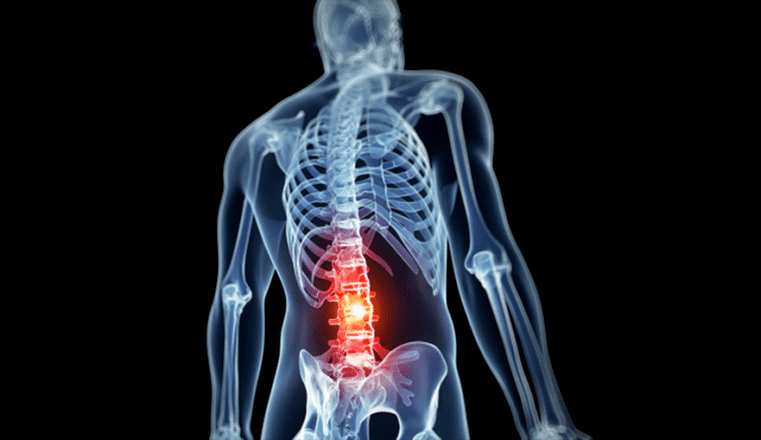
Osteochondrosis is the most severe form of degenerative lesions of the spine, based on damage to the structure of the intervertebral disc located between the vertebrae. If the symptoms of lumbar osteochondrosis are not recognized as early as possible, this condition causes deformation of the organs of the adjacent vertebrae, intervertebral joints. Blood vessels and the nervous system are involved in the pathological process.
One of the most common forms of this disease is lumbar osteochondrosis, the symptoms in women and men are very similar. Many adults have repeatedly felt discomfort in the lower back, sacrum, legs, which is caused by osteochondrosis and its complications. Among all the causes of the loss of the ability to move normally, this disease takes one of the first places.
The reasons
One of the causes of the disease is poor posture, but there are others:
- Osteochondrosis of the lumbosacral spine, whose symptoms and treatment cause a lot of discomfort to the patient, occurs most often due to increased stress on the spine. Therefore, the disease manifests itself more often in those whose labor activities are related to physical labor and weight lifting.
- Another factor that provokes the disease is excess weight, which increases the pressure on the spine.
- The lack of any load and physical inactivity worsens the nutrition of disc tissues and slows down blood flow and metabolic processes in the spine. The muscle corset weakens significantly and creates a favorable background for the development of pathological changes.
- Incorrect body position, if the patient likes to sit with a bent spine, causes the load on the discs and vertebrae to be uneven, the discs become deformed and wear out quickly.
- Injuries can be the cause of lumbar osteochondrosis, whose symptoms often bring a lot of trouble to the patient's life. It happens during sports, doing exercises without proper preparation, not lifting heavy weights properly, injuries when falling.
- Some experts believe that osteochondrosis is predetermined even at the genetic level, regardless of the department in which degenerative changes are observed.
- The age of the patient also has a special effect: over the years, the segments of the spinal column lose their mobility and flexibility, and therefore are subject to destruction and deformation. Previously, osteochondrosis of the back, whose symptoms were quite unpleasant, was considered a disease of the elderly, but today it is found in young people aged 25-30.
- A predisposing factor can be some pathologies accompanied by inflammation in the joints of the spine or changes in its structure and shape: ankylosing spondylitis, arthritis, scoliosis, disc instability.
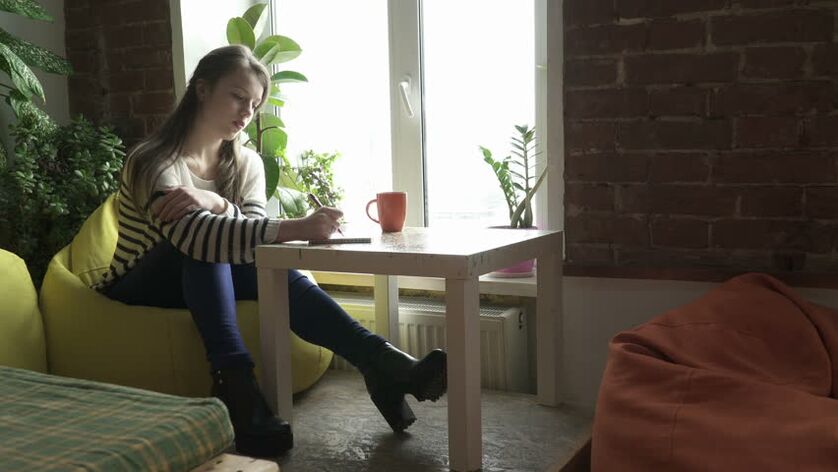
In rare cases, the reason for the development of osteochondrosis can be:
- hypothermia;
- stress;
- nutrition;
- violation of work and rest regime;
- poor environmental conditions.
It is better to consult a doctor at the first appearance of discomfort in the lumbar region.
Classification according to degrees of osteochondrosis
The classification of osteochondrosis according to degrees is used to systematically characterize the clinical manifestations of the disease. The classification allows to describe the symptoms of lumbar osteochondrosis and to determine exactly at what moment the patient begins to worry about pain:
- The first degree occurs when the disc ruptures, which is provoked by sudden movements. It manifests itself in the form of severe sudden pain, there is a feeling of shock in the spine, the muscles tense up reflexively.
- Secondary symptoms resemble intervertebral protrusion and instability of the vertebral body. The pain is aggravated by physical activity. Constantly changing exacerbations and remissions. If osteochondrosis occurs in the neck, then the pain intensifies when a person stays in one position for a long time, often has headaches, discomfort in the arms and shoulders, fatigue in the lower limbs.
- Third-degree disc herniation manifests itself as symptoms: numbness of the limbs, changes in posture and gait, headaches and discomfort along the affected nerve. Symptoms are similar to kidney disease, gastrointestinal tract, disorders in the reproductive system.
- The fourth degree begins with the fact that the hernia is not felt, the manifestations may weaken, but the signs of instability of the vertebral body and torsion of the vertebrae still persist. In addition, growths of the vertebral bodies can often be seen, which compress the spinal nerves or block the canal, pressing the brain back. If the hernia was surgically removed, this rate can be attributed to the results of the operation.
Osteochondrosis of the lumbar spine, the symptoms of which cause a lot of discomfort, is a very unpleasant disease. Urgent complex treatment and constant supervision by a specialist is required.
Symptoms of pathology
Depending on the symptoms, the treatment of lumbar osteochondrosis can be different. This is due to the fact that the disease affects the nervous system, so there are often problems in different parts of the body that are in no way related to the back.
In the early stages of the disease, pain may appear after heavy physical exertion or a long stay in one position, for example, a person often spends time sitting at a computer. As the disease progresses, the pain becomes chronic. If the pain syndrome does not manifest itself, it can be replaced by discomfort that interferes with normal life. The complex of symptoms can be as follows:
- pain in the lower back, often spreading to the hip or leg;
- spasms in the muscles with a long stay in a static position;
- constant tension of the back muscles;
- shooting in the back, which most often occurs after a person has been in the cold for a long time;
- sensory disturbances in the lower part of the patient's body;
- numbness of the legs, frequent tingling in the fingers;
- cold feet;
- sweating dysfunction;
- drying of the skin in the area where the pain appears.
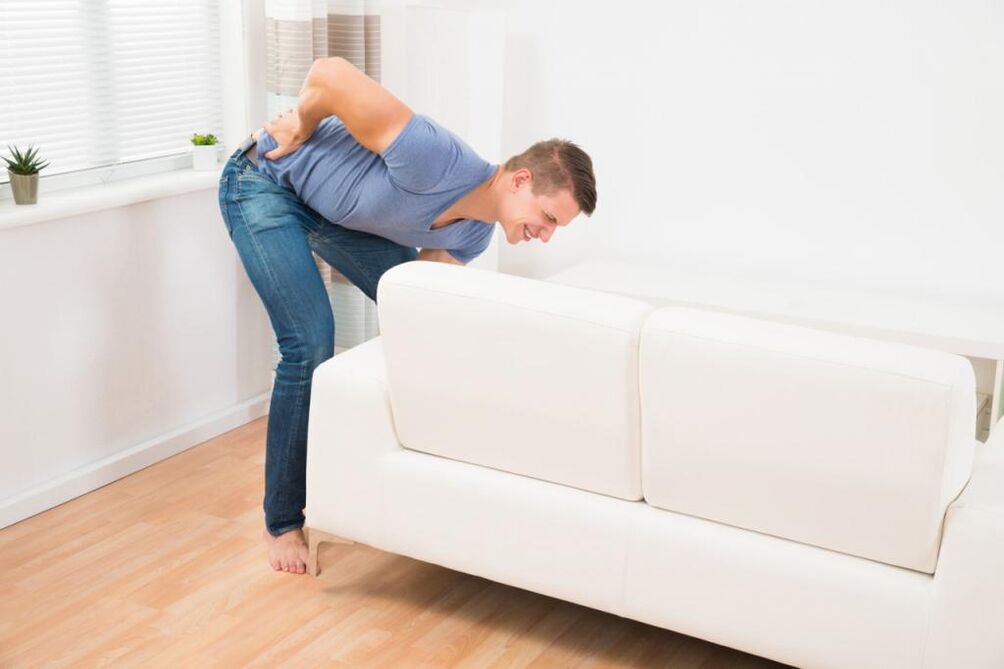
If no measures are taken to treat the patient or if one of the provoking factors increases, the symptoms of lumbar osteochondrosis may worsen. In this case, the pain syndrome goes to the lower limbs. A person tries to find the most optimal position in order to alleviate his condition and not to feel the unpleasant discomfort caused by the disease.
Diagnostic methods
First, before starting the diagnosis, the doctor must collect the patient's anamnesis, carefully examine him, and assess his health. In addition, instrumental examination methods may be required.
A complete history will allow the doctor to suggest what causes the symptoms of osteochondrosis of the lumbosacral spine, as well as to assess the risks of its occurrence. Examination of the patient consists of palpation of painful areas, percussion, external examination of the skin. In some patients, the doctor can test sensitivity using acupuncture.
Based on the information collected by the doctor, the patient is recommended to undergo additional instrumental studies to confirm the diagnosis and determine how the spine and other organs are affected. The patient is advised to undergo the following:
- radiography;
- MRI;
- CT.
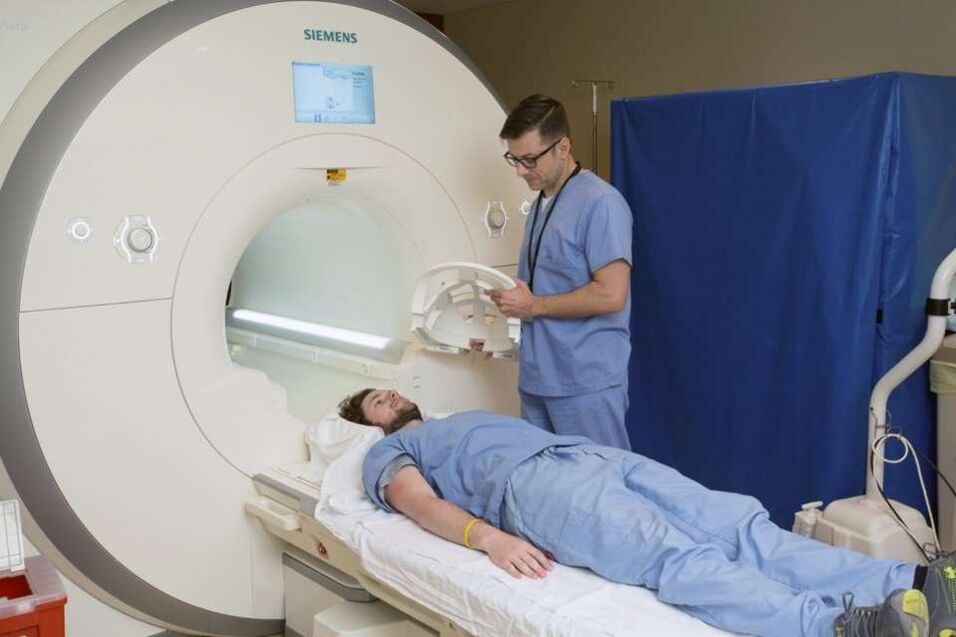
All these diagnostic methods help to determine some features of the development of the disease. MRI is considered the most informative of them, and all because other methods capture images of the human body only in a few projections and do not allow a closer look at the whole problem.
The treatment of lumbar osteochondrosis, the symptoms of which begin to bother a person, is selected by the doctor. It is not possible to make a diagnosis and prescribe a course of therapy only by external examination, it is important to conduct a comprehensive examination and prevent complications.
Treatment of osteochondrosis of the lower back
Osteochondrosis cannot be completely cured. Good results can be obtained if the patient has 1 and 2 degrees of the disease. But in any case, long-term treatment of osteochondrosis of the lumbosacral region will be required, because the symptoms are unbearable, they are very strong and unpleasant. Therapy is aimed at:
- reduce the intensity of pain in the lumbosacral region;
- eliminate muscle tension that does not allow a person to relax;
- strengthen the muscles of the back, hips and lower extremities;
- normalize blood flow and metabolic processes in the affected area;
- eliminate the inflammatory process;
- restore the normal range of motion in the lumbar region and increase the sensitivity of the legs;
- improve the work of organs of the reproductive and excretory systems.
Among the drugs, the doctor prefers the following:
- Definitely recommend pain relievers. Analgesics help relieve pain, but they cannot eliminate the causes of the disease.
- NSAIDs are used to relieve swelling and radicular pain, and in severe cases, steroid-based drugs are used to relieve the symptoms of lumbar osteochondrosis in women and men. Their action is aimed at reducing and eliminating inflammation.
- Paravertebral blocks are used for local anesthesia. The drug is applied along the lumbar region. More often they are recommended for patients with 3-4 degrees of the disease.
- Muscle relaxants are recommended to relieve spastic muscle contraction.
- Chondroprotectors improve metabolic processes in cartilage tissue, stimulate regenerative processes and significantly slow down their deformation.
- B vitamins help improve cell metabolism, reduce inflammation, and remove excess fluid from the body.
- Diuretics help relieve bloating.
- Immunostimulants increase the activity of the immune system and improve the body's defenses.
- Means to improve blood flow in the area affected by the disease, administered intravenously by drip.
Complementary Therapies
The doctor may additionally recommend physiotherapy methods. Medicines alone will not be enough to treat osteochondrosis of the lumbar sacral region, the symptoms of which bring pain to the patient. The following physiotherapy procedures are recommended to improve metabolic processes to relieve pain and relieve muscle spasm:
- amplipulse;
- electrophoresis;
- diadynamic currents;
- magnetic resonance therapy;
- magnetotherapy;
- laser treatment.
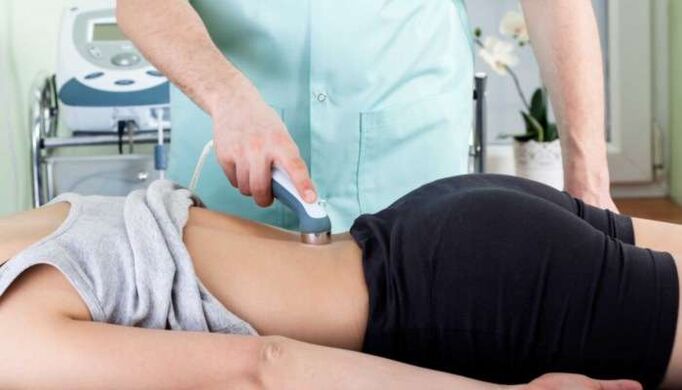
There will be no more therapeutic gymnastics either, because with its help you can not only relieve the pain syndrome, but also strengthen and relax the back muscles. Physical exercises can be done not only during the exacerbation of the pathology, but also during recovery. Massage and reflexology give excellent results.
Surgery
For some patients with stage 4 disease, surgery may be recommended. This measure is used in cases where drug treatment does not give the desired result with the appearance of severe neurological and motor disorders and the appearance of hernias. During the operation, the herniated discs are removed, after which plastic surgery is performed, the displaced vertebrae are securely fixed.
Folk remedies
Symptoms of lumbar osteochondrosis in men are not much different from those observed in women. Therapeutic measures are selected individually for each patient depending on the stage of the disease. In addition to traditional treatment methods, traditional medicine may be recommended. The patient must coordinate all his actions with the doctor. Good results in complex treatment were given by such herbal products:
- To prepare an ointment that improves blood circulation in the affected area, you need to take five red peppers and 1/2 cup of kerosene and vegetable oil. After receiving the therapeutic infusion, it is necessary to lubricate the painful areas at night. Place a dry wool compress over the treated area.
- Mix equal amounts of butter and hop cones, this composition is applied to the lower back when there is no strength to bear the pain and discomfort.
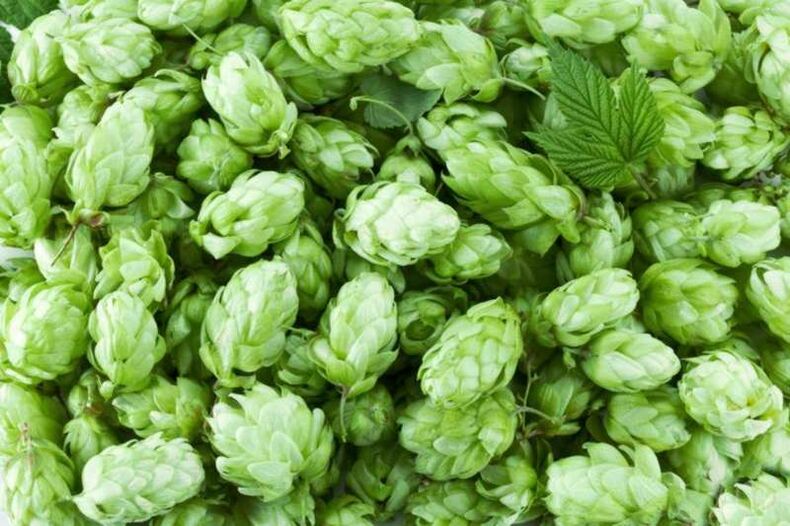
Folk remedies show good results in the early stages of treatment of lumbar osteochondrosis, the symptoms of this pathology gradually disappear. It is better to use such recipes immediately after the first signs of the disease appear.
Consequences of the disease
Symptoms of lumbar osteochondrosis in men and women cause serious discomfort, a person cannot sit normally, sleep well and is constantly worried. If no timely measures are taken at the first manifestations of the disease, osteochondrosis can cause serious complications in the form of inflammation of the sciatic nerve. This disease is characterized by severe pain in the back and legs, possibly numbness of the limbs. To try to alleviate the pain, many patients walk bent over on the healthy side, but this position only aggravates the disease: the degree of curvature of the vertebral body increases and the process of disc destruction accelerates.
Vertebral instability can be considered the most dangerous complication. The intervertebral discs cannot cope with the fixation function of the vertebrae, and under a heavy load, the lumbar region begins to slide down from the sacrum. This condition can result in disruption of internal organ systems. Women may have inflammation of the uterus, appendages, and men have problems with potency.
Preventive measures
You can prevent the disease if you use the following methods:
- remove heavy loads on the lower back;
- strengthen back muscles;
- maintain proper posture;
- strengthen the spine with regular physical activity;
- follow a proper diet;
- regulate rest;
- treat back pain in time.

Only a timely visit to the doctor and comprehensive treatment will give a chance to avoid complications and return to the previous lifestyle.














































